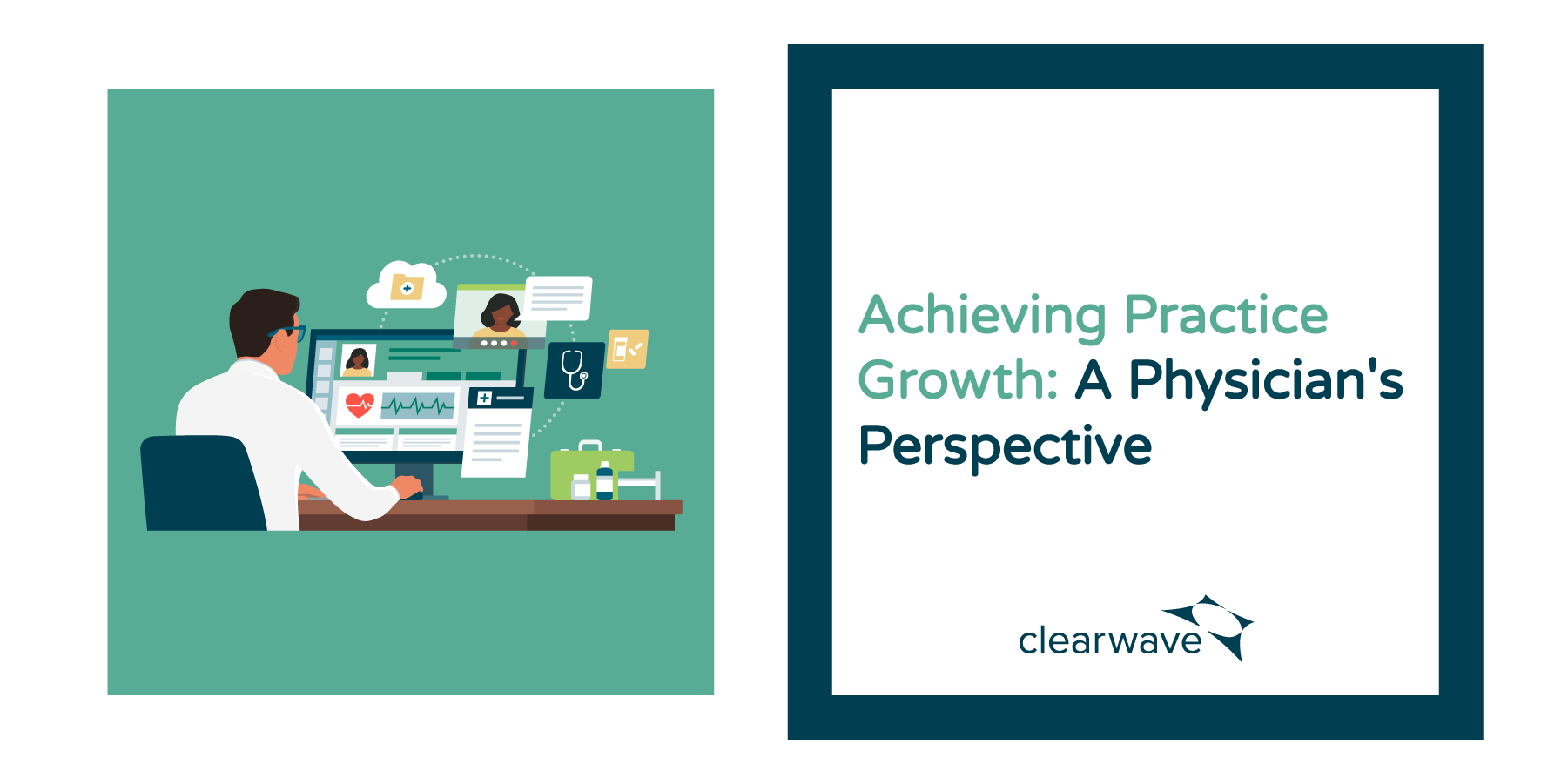Achieving Practice Growth: A Physician’s Perspective

Increasing practice growth is not just a goal, but a necessity for specialty physicians in today’s healthcare landscape.
According to the Medical Group Management Association (MGMA), top-performing practices have demonstrated the potential to generate nearly $138,522 more revenue per year per full-time physician compared to their counterparts. This impressive statistic underscores the importance of optimizing various aspects of your practice to unlock its growth potential. Keep reading to learn more about the key areas that specialty physicians should focus on to accelerate the growth of their practices.
1. Maximizing Patient Collections
The financial health of your practice relies on efficient and consistent patient collections. However, challenges such as staff shortages and inconsistent payment processes can lead to revenue leakage.
Staff limitations in terms of availability, susceptibility to human error and inefficiencies in processing payments can hinder revenue collection and recognition. Additionally, relying solely on staff for follow-ups may result in delayed collections and scalability challenges as your practice expands. To address these issues, it’s crucial to complement staff efforts with technology and streamlined processes, allowing for a more efficient and comprehensive approach to revenue management.
Roadblocks to in-office patient collections, like busy wait rooms, patient portals, overwhelmed administrative staff and outdated insurance verification, hinder patient collections. While you may think your administrative staff does a fair job at capturing point-of-service collections, without a self-service solution you leave room for human error. Staff may feel too busy or too awkward to ask, and it can be difficult to truly determine if payments are collected at each check-in. High-performing practices recognize the significance of capturing earned revenue promptly and accurately.
Today, 40% of providers say staff shortages have been offset by technology improvements. Here are two ways you can achieve similar efficiencies to boost profits.
-
Implement Patient Self-Registration
One effective solution is patient self-registration, offered through kiosks or mobile pre-registration. By utilizing self-registration, you can enable patients to check in and make payments on their own, streamlining the collection process and reducing the risk of missed chances to collect patient payments. Self-registration allows your administrative staff to focus on more patient-centered tasks, enhancing the overall patient experience.
-
Automate Insurance Verification
Another crucial step is automating insurance verification. To collect payment at check-in and increase collections, you first have to know what patients own, prior to them arriving at the office. By automating patient insurance eligibility verification, you can reduce staff time spent trying to determine responsibility and make the process simple and quick so you can capture payment every time a patient checks in.
Real-time, fee-free verification tools integrated with multiple payers can accelerate the time-to-payment process. By verifying insurance ahead of time, you can ensure accurate co-pay collections at each check-in, thus minimizing rejections, refunds and write-offs.
2. Addressing Acquisition Costs & Scheduling Gaps
The efficiency of your scheduling process plays a pivotal role in minimizing no-shows, cancellations and unutilized time slots. These factors directly impact your practice’s revenue streams and patient acquisition costs, after all bringing in more patients remains a top reason for physician revenue generation.
One study found that no-shows cost the U.S. healthcare system more than $150 billion a year and individual physicians an average of $200 per unused time slot. Moreover, patient attrition rates in the U.S. average around 17%, which translates to approximately 425 patients leaving your practice annually in a healthy patient base of 2,500 active patients.
Furthermore, research shows that 60% of patients are likely to choose one doctor over another if they have the option to make appointments online. Failing to offer self-scheduling options not only results in financial losses but also risks losing loyal patients who seek the convenience of digital appointment booking. These statistics underscore the critical importance of optimizing your scheduling process to enhance both patient retention and practice revenue. Here are two ways you can bring in more patients than ever before.
-
Implement 24/7 Online Scheduling
Offer patients the convenience of online scheduling, including after business hours to attract more patients and reduce appointment gaps.
The Orthopedic Group is a great example of how you can boost patient acquisition by providing new and existing patients with the option to book after hours and last minute appointments.
By incorporating these booking options that take place after normal business hours, your practice can increase the chances of booking patients that may have otherwise looked elsewhere.
The integration of after-hours online scheduling aligns with the realities of patients’ busy lives. With the majority of appointments being scheduled outside regular business hours, offering a 24/7 online scheduling platform caters to patient needs, ensuring they can book appointments when it’s most convenient for them. This not only bolsters patient engagement but also translates into reduced appointment gaps and a more optimized practice schedule. As practices adapt to these modern scheduling strategies, they stand to benefit from increased efficiency, revenue, and patient retention.
-
Use a Waitlists
As a highly in-demand physician, you may be booked out for months. This long waiting period can be frustrating for your patients, and frustrating for you when last-minute appointment gaps do occur. By utilizing a patient waitlist, you can optimize your schedule and promptly fill any last-minute cancellations or gaps. This can allow you to increase patient throughput and provide more care to your patients.
A smart waitlist enables patients to get on the list to be notified if a last-minute opening occurs. A waitlist further streamlines your schedule, ensuring you have a built-in mechanism that fills gaps for you, keeping your patients happy and earning you more every day.
3. Enhancing Patient Retention & Reputation Management
Patient satisfaction goes beyond just clinical care. Long wait times and poor online experiences can tarnish your reputation and hinder patient retention, directly affecting your bottom line. Furthermore, ensuring that your practice has a good reputation in the community can go a long way in attracting more patients to your practice. Here are three ways to manage your reputation to boost patient acquisition and loyalty.
-
Encourage Reviews
An astounding 74% of patients place great importance on online reviews when selecting a new doctor. This underscores the critical role that a positive online reputation plays in attracting new patients. Encouraging current patients to write reviews can increase patient retention and attract new patients. Since 59% of patients are likely to provide feedback via online review, it’s equally important to ensure that each patient has a positive first-impression experience.
-
Prioritize Short Wait Times
68% of patients considered a fast check-in process as important to their in-office experience. Efficient patient check-in processes, such as pre-registration and self-service kiosks, can significantly reduce wait times and enhance patient satisfaction. These streamlined procedures allow you to focus on providing quality care while improving patient throughput. With nearly 60% of patients likely to provide feedback via survey after an appointment, speeding up check-in times can help you ensure positive feedback, versus angry responses that steer away future patients.
-
Provide Convenient Patient Communications
Patient portals, while useful for certain functions, may not always serve the purpose of revenue-related communications. Password-free and portal-free communication methods, such as text messages, email and voice reminders or recalls, can enhance patient engagement and ensure critical messages are received. This step is key to getting your patients back in the door for their upcoming appointments and reducing lapsed patients.
See More Patients & Increase Loyalty With a Proven Solution
Incorporating these strategies into your practice’s approach can propel it into the realm of top-performing practices. By optimizing patient collections, addressing acquisition costs and scheduling gaps and focusing on patient retention and reputation management, specialty physicians can unlock their practice’s growth potential.
Patient-centered strategies that enhance revenue can set your practice on a path to sustainable growth. Uncover 3 more ways physicians are losing money and get tips to stop profit leakage. Find the one solution you need to patch up revenue gaps.
Recommended for you
Related Posts
3 Ways to Improve OBGYN Patient Communications
Reading Time: 4 minutes Patients expect timely and personalized communication from their healthcare providers, especially when they’re preparing for major life changes related to…
Long-Lines Giving You Blurry Vision?
Reading Time: 4 minutes Clearwave & Thomas Eye Group’s 10-Year Partnership Puts Patients First By Blakely Roth | June 18, 2024 In an era…
3 Ways to Gastroenterology Practices Use Patient Check-in Software to Augment Staff Workloads
Reading Time: 4 minutes By Chloe From Clearwave | June 13, 2014 The healthcare industry is battling a multi-faceted workforce crisis, and no specialty…




